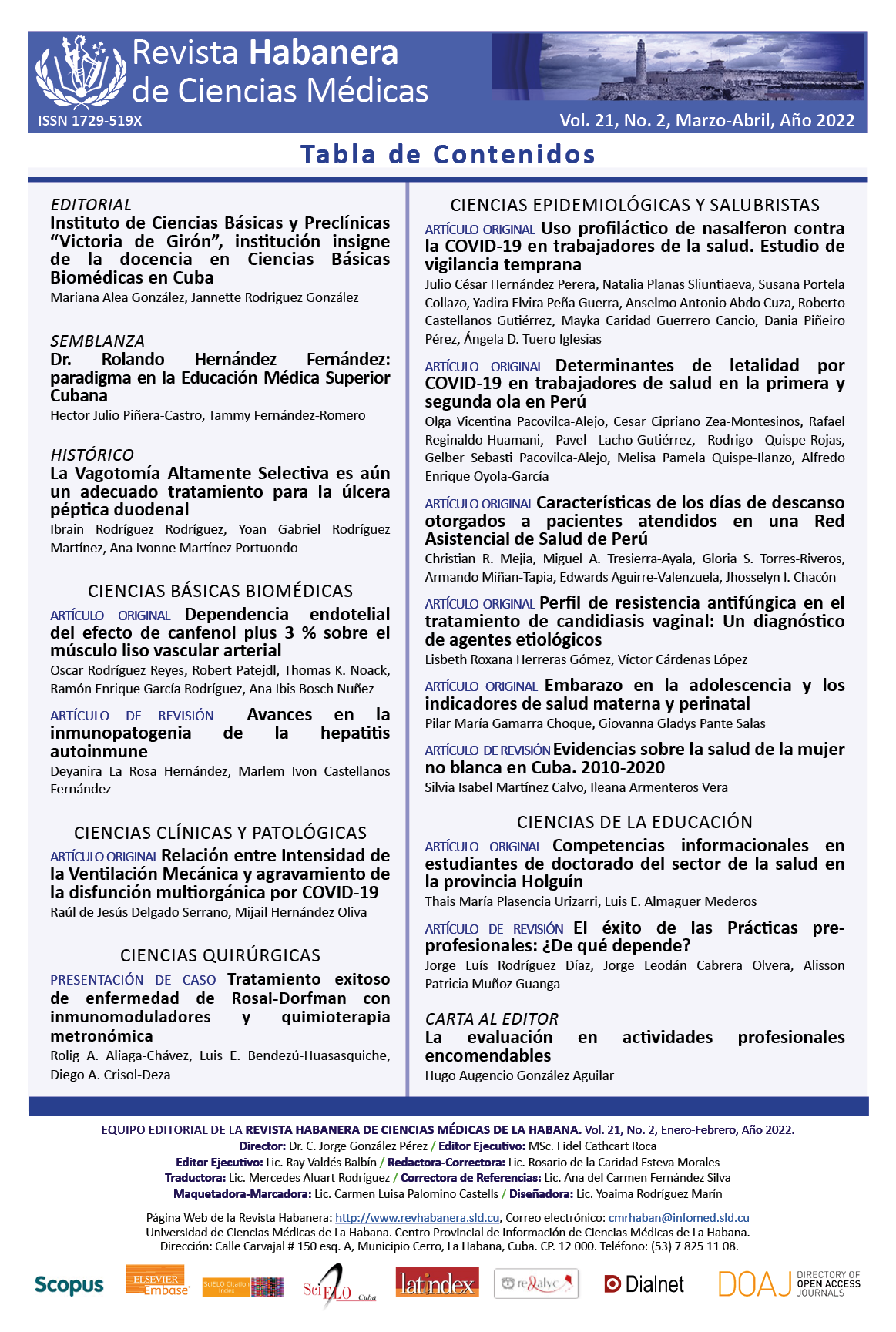Relationship between intensity of mechanical ventilation and multiple organ dysfunction worsening by COVID-19
Keywords:
Mechanical power, driving pressure, delta SOFA, COVID-19.Abstract
Introduction: The intensity of mechanical ventilation is reflected by driving pressure and mechanical power. It is a predictor of ventilator-induced lung injury and it can be associated with mortality.
Objective: To determine if there is a relationship between intensity of mechanical ventilation and ΔSOFA>0 (worsening) in patients with COVID-19 at 72 h after intubation.
Material and Methods: Study group composed of 35 COVID-19 patients who were ventilated for more than 72 hours. Chi-square test (X2) or Fisher’s exact test was used to compare qualitative variables; Student t test or Mann-Whitney U test was employed for quantitative ones. A Simple Binary Logistic Regression Model was performed in order to find the relationship between variables and dichotomized ΔSOFA for ΔSOFA≤0 and ΔSOFA>0. The discriminatory capacity of the models was tested by using ROC Curve.
Results: A total of 21 patients (60 %) presented ΔSOFA>0 (worsening). No significant differences related to Driving Pressure were found between the two groups (15 vs. 18, U=94,00, z= -1,795, p=0,77). Mechanical Power (OR 3,421 [95 % CI 1,510 a 7,750, p=0,003]) and Tidal Volume (OR 1,03 [95 % CI 1,012 a 1,068], p=0,005) were good predictors of ΔSOFA>0. The Predictive Model of ΔSOFA>0 depending on Mechanical Power (AUC 0,888 [95 % CI 0,775 a 1], p<0,001) showed a good discriminatory capacity.
Conclusions: Mechanical Power is related to multi-organ dysfunction worsening in mechanically ventilated patients with COVID-19.
Downloads
References
1. Malik P, Patel U, Mehta D, Patel N, Kelkar R, Akrmah M, et al. Biomarkers and outcomes of COVID-19 hospitalisations: systematic review and meta-analysis. BMJ Evid Based Med [internet]. 2021 Jun [cited 2021 Sep];26(3):107-108. Disponible en: doi: 10.1136/bmjebm-2020-111536.
2. Parasher A. COVID-19: Current understanding of its Pathophysiology, Clinical presentation and Treatment. Postgrad Med J [internet]. 2021 May[cited 2021 Apr];97(1147):312-320. Disponible en: doi: 10.1136/postgradmedj-2020-138577.
3. Tonetti T, Vasques F, Rapetti F, Maiolo G, Collino F, Romitti F, et al. Driving pressure and mechanical power: new targets for VILI prevention. Ann Transl Med [internet]. 2017 Jul [cited 2021 Oct];5(14):286. Disponible en: doi: 10.21037/atm.2017.07.08.
4. Irwin RS, Lilly CM, Mayo PH, Rippe JM, editors. Intensive Care Medicine. 8th ed. Philadelphia: Wolters Kluwer; 2018.
5. de Grooth HJ, Geenen IL, Girbes AR, Vincent JL, Parienti JJ, Oudemans-van Straaten HM. SOFA and mortality endpoints in randomized controlled trials: a systematic review and meta-regression analysis. Crit Care [internet]. 2017 Feb 24 [cited 2020 Nov];21(1):38. Disponible en: doi: 10.1186/s13054-017-1609-1.
6. Schuijt MTU, Schultz MJ, Paulus F, Serpa Neto A; PRoVENT–COVID Collaborative Group. Association of intensity of ventilation with 28-day mortality in COVID-19 patients with acute respiratory failure: insights from the PRoVENT-COVID study. Crit Care[internet]. 2021 Aug 6[cited 2021 Jul];25(1):283. Disponible en: doi: 10.1186/s13054-021-03710-6.
7. Patel BV, Haar S, Handslip R, Auepanwiriyakul C, Lee TM, Patel S, et al. Natural history, trajectory, and management of mechanically ventilated COVID-19 patients in the United Kingdom. Intensive Care Med [internet]. 2021 May [cited 2021 Sep];47(5):549-565. Disponible en: doi: 10.1007/s00134-021-06389-z.
8. Lascarrou JB, Gaultier A, Soumagne T, Serck N, Sauneuf B, Piagnerelli M; COVADIS study group. Identifying Clinical Phenotypes in Moderate to Severe Acute Respiratory Distress Syndrome Related to COVID-19: The COVADIS Study. Front Med (Lausanne) [internet]. 2021 Mar 11 [cited 2021 Jul]; 8:632933. Disponible en: doi: 10.3389/fmed.2021.632933.
9. Ferrando C, Suarez-Sipmann F, Mellado-Artigas R, Hernández M, Gea A, Arruti E; COVID-19 Spanish ICU Network. Clinical features, ventilatory management, and outcome of ARDS caused by COVID-19 are similar to other causes of ARDS. Intensive Care Med [internet]. 2020 Dec [cited 2021 Jul];46(12):2200-2211. Disponible en: doi: 10.1007/s00134-020-06192-2.
10. Guérin C, Papazian L, Reignier J, Ayzac L, Loundou A, Forel JM; investigators of the Acurasys and Proseva trials. Effect of driving pressure on mortality in ARDS patients during lung protective mechanical ventilation in two randomized controlled trials. Crit Care[internet]. 2016 Nov 29[cited 2020Dec] ;20(1):384. Disponible en: doi: 10.1186/s13054-016-1556-2.
11. Coppola S, Caccioppola A, Froio S, Formenti P, De Giorgis V, Galanti V, et al. Effect of mechanical power on intensive care mortality in ARDS patients. Crit Care [internet]. 2020 May 24 [cited 2021 Oct];24(1):246. Disponible en: doi: 10.1186/s13054-020-02963-x.
12. Yildirim S, Cinleti BA, Saygili SM, Senel E, Ediboglu O, Kirakli C. The effect of driving pressures in COVID-19 ARDS: Lower may still be better as in classic ARDS. Respir Investig [internet]. 2021 Sep [cited 2021 Oct] ;59(5):628-634. Disponible en: doi: 10.1016/j.resinv.2021.06.002.
13. Boscolo A, Sella N, Lorenzoni G, Pettenuzzo T, Pasin L, Pretto C; COVID-19 VENETO ICU Network. Static compliance and driving pressure are associated with ICU mortality in intubated COVID-19 ARDS. Crit Care[internet]. 2021 Jul 28[cited 2021 Sep];25(1):263. Disponible en: doi: 10.1186/s13054-021-03667-6.
14. Urner M, Jüni P, Hansen B, Wettstein MS, Ferguson ND, Fan E. Time-varying intensity of mechanical ventilation and mortality in patients with acute respiratory failure: a registry-based, prospective cohort study. Lancet Respir Med [internet]. 2020 Sep [cited 2020Nov];8(9):905-913. Disponible en: doi: 10.1016/S2213-2600(20)30325-8.



